The typical Dutch food consists in a few simple ingredients: potatoes, cabbage, beef, fish, cheese, butter and bread. These few main ingredients come in a series of forms listed below.
The characteristics of the typical Dutch cuisine are that:
- Almost everything is either mashed or deep-fried
- Most people eat sandwiches for lunch, only the dinner is the time for more elaborate dishes
Then come the modern dishes, which are characterized by mixing everything with everything – a Dutch dish may contain at the same time mushroom, beans, cream, broccoli, beetroot and pear – let’s just say that sometimes less is more ;)
There is one field in which the Dutch food is truly excellent: cakes and cookies. They are extremely tasty, so we present a wide selection below.
List of Contents
1. Vegetarian Dishes
2. Vegan Dishes
3. Fish Dishes
4. Meat Dishes
5. Desserts
6. Drinks
1. Typical Dutch Food: Vegetarian Dishes
1.1. Stamppot – Mashed Vegetables

Typical Dutch food – stamppot – in this version called hutspot
The national Dutch dish is undoubtly Stamppot. It means “mashed pot” and it contains mashed potatoes with some other mashed evegetables, which are usually one or more of the following: carrot, spinach, sauerkraut, kale, onions. It is often served with a sausage or fried bacon, but you may ask just for the vegetarian Stamppot on its own.
The most popular types of Stamppots include the following:
- Hutspot – potatoes, carrots, onions (often served with rookworst sausage)
- Andijviestamppot – potatoes, raw endive (often served with diced fried bacon)
- Zuurkoolstamppot – potatoes, sauerkraut (often served with fried bacon or a sausage)
- Boerenkoolstamppot – potatoes, kale, often served with gravy, mustard (and rookworst sausage)
1.2. Kaaskroketten – Cheese Croquettes

Kaaskroketten – Cheese croquettes
There are several typical Dutch deep-fried snacks, but almost all are made of meat or fish. The only vegetarian option, usually available in pubs and bars are cheese croquettes.
1.3. Mosterdsoep – Mustard soup
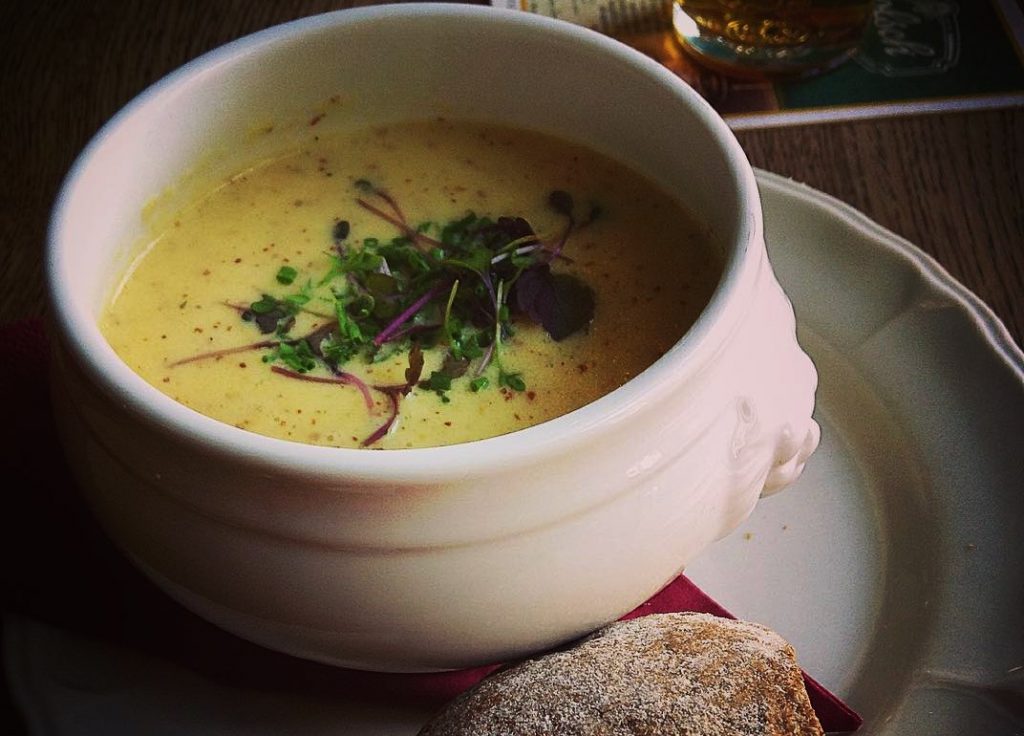
Mustard soup
For me it was the greatest discovery in the Dutch cuisine – surprising and unique. Mustard soup is typical for nothern part of the Netherlands, in particular Groeningen, but you can find it throughout the country. The taste is pleasantly balanced – with the characteristic note of mustard, but in a creamy version, not too spicy, usually cooked with leeks. The mustard soup is sometimes vegetarian, sometimes not and often served with fried bacon, so ask the details before ordering.
1.4. Kaas – Best Dutch Cheeses
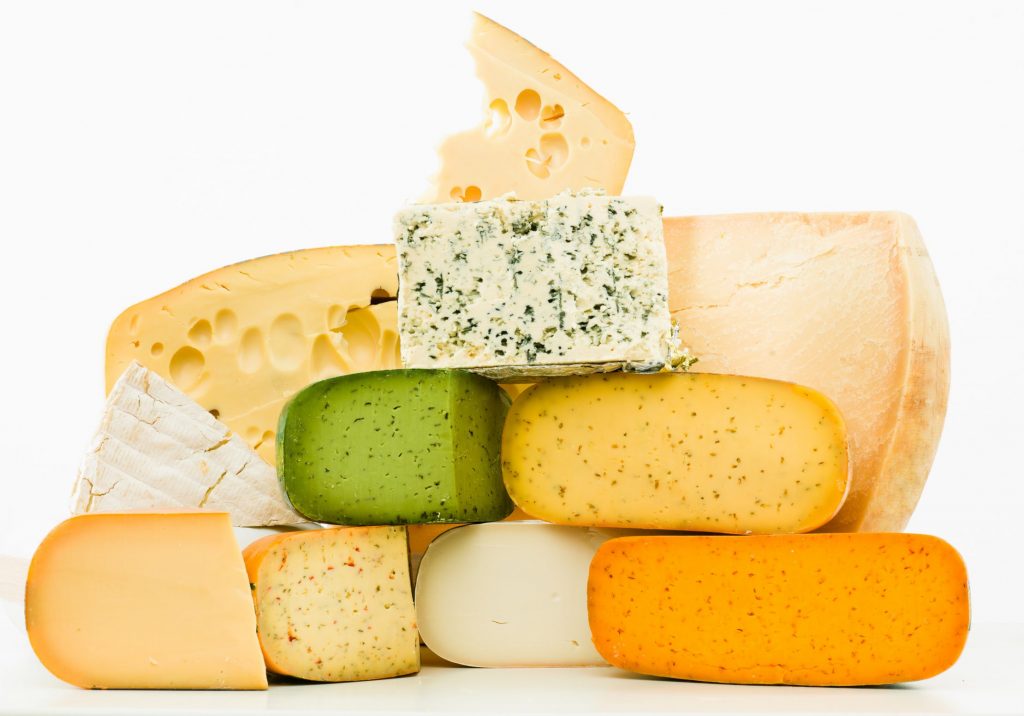
A selection of Dutch cheeses
When it comes to cheeses, the Dutch can really show off their heritage. There is a great choice of Dutch cheeses – here is a suggestion of the most famous ones to try (almost all of them are on the photo above):
- Gouda – arguably the world’s most popular type of cheese. Even if you think you have it also back home, trust me – the real Dutch Gouda is another level. It is a semi-hard cow-milk cheese and it appears in a variety of flavours and aged versions. You can try champagne Gouda, beer Gouda, liquorice & lemon Gouda (completely black!), truffle Gouda and many other.
- Edam – another delicious world-famous semi-hard cow-milk cheese
- Maasdam and Leerdammer – cow-milk cheeses with huge round holes and a sweet and a bit nutty taste.
- Boerenkaas – “farmhouse cheese” is made of raw unpasteurised cow-milk, which gives it an extra-rich flavour.
- Geitenkaas – semi-hard goat-milk cheese. Excellent, one of my favourites.
- Nagelkaas – extremely original aromatic hard cow-milk cheese with cloves. Remarkable and unique.
- Kruidenkaas – variety of cheese with herbs.
- Rookkaas – smoked cow-milk cheese.
- Blauwe kaas – a velvety blue-veined cheese with sweet and nutty taste, different than salty French blue cheeses. The most typical is called Delftse Blauw from Delft.
- Leidsekaas – intense, spicy, crumbly mature cheese with cumin, made of skimmed cow-milk, from Leiden.
Read about the traditional Cheese Markets in the Netherlands
Read where to buy best cheese – Shopping in Amsterdam
2. Typical Dutch Food: Vegan Dishes
The Netherlands is a very progressive and eco-friendly country, and actually many Dutch people are vegan, so in the main cities you will easily find vegan restaurants.
When it comes to the popular and typical Dutch dishes, the only dish that is fully vegan would be Belgian-style fries.
2.1. Friet – Belgian-Style Fries
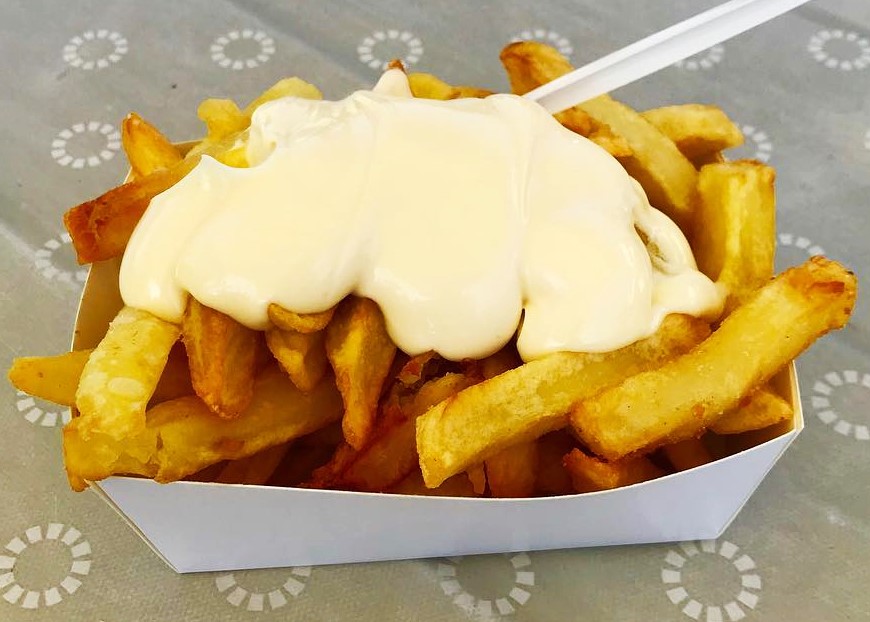
Friet / Frites
Dutch love potatoes. Especially fried potatoes. Dutch fries are often cut in wider pieces than the classic fries and they are always served with sauce. Usually it’s mayonnaise or sometimes ketchup, but the Dutch (and Belgians) take sauces for fries seriously – you always have a selection of at least a few, and often of even 20 or more.
Attention: most sauces are not vegan (they are often based on mayonnaise). Always ask the staff.
The most popular Dutch sauces incude:
- Joppiesaus – a Dutch classic – mayonnaise base with little pieces of chopped onion and curry powder.
- Curry sauce – attention! It’s not really like Indian curry taste, it’s more like spiced ketchup (vegan)
- Peanut sauce – similar to peanut butter taste (vegan)
Euroviajar’s Tip: Other Vegan Options
Another great option for vegans are Asian restaurants – extremely popular in the Netherlands. Due to huge population from different Asian countries (Indonesia, China, Thailand, India etc.) living in the Netherlands, there are restaurants representing authentic exquisite cuisines to try out. Actually, the best Asian food I’ve had in Europe was always in the Netherlands. I definitely recommend you to go for it. See also section 4.8. Indonesian Rijsttafel below.
3. Typical Dutch Food: Fish Dishes
3.1. Haring (Hollandse Nieuwe) – Raw Herring
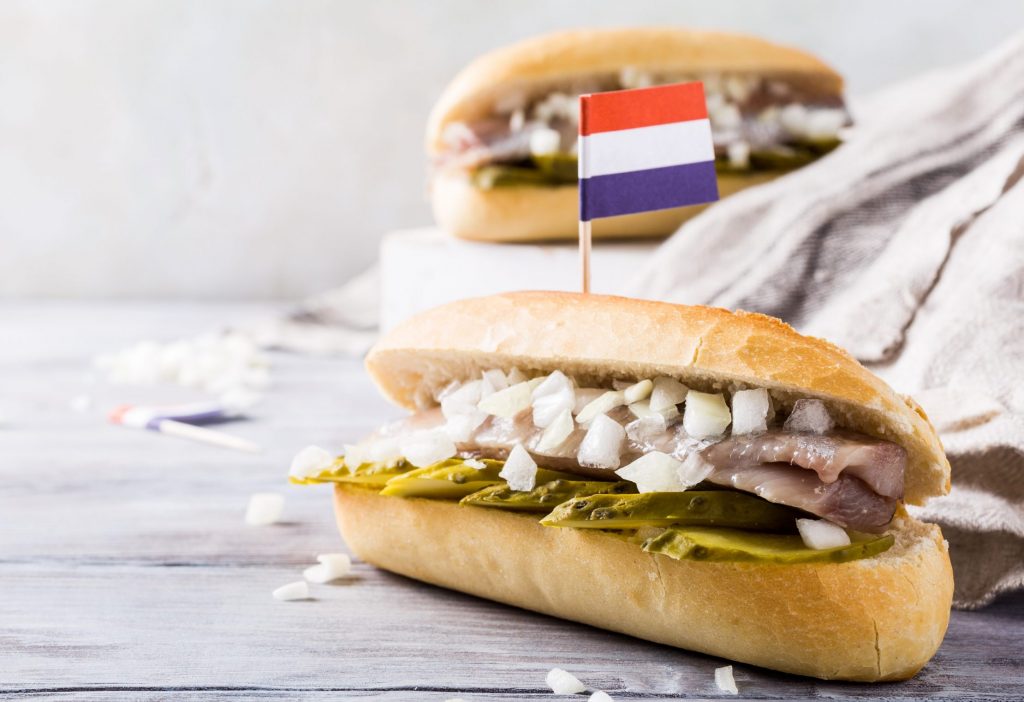
Typical Dutch food – fresh herring
Herring is one of the most common fish species worldwide, but interestingly, it’s also one prepared in most different ways in various countries. The Dutch approach to herring is unique: they serve it raw. It is brined (salted) and served with fresh chopped onions and pickled cucumber, and optionally in a bread roll or without bread.
There is also a funny special way of eating it, apparently traditional. Since it’s street food, you should eat it standing, tilting your head backwards and putting the fish to your mouth from above.
3.2. Lekkerbekje / Kibbeling – Fried Fish
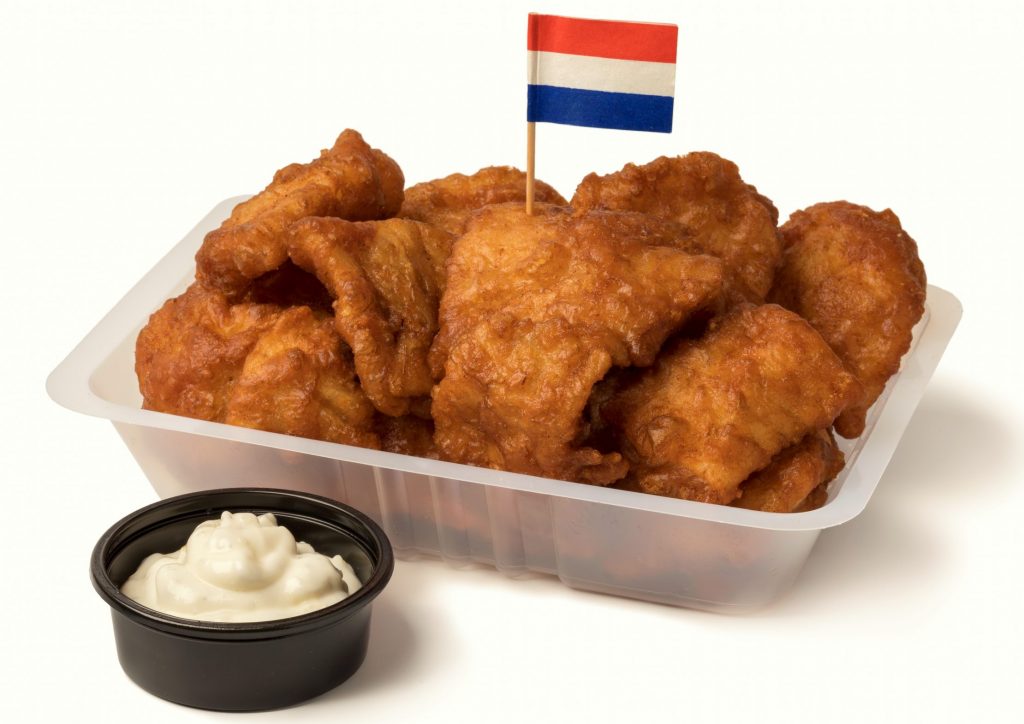
Traditional Dutch kibbeling
Kibbeling consits in pieces of deep-fried fish, usually cod or hake. It is often served with fries – making it a Dutch version of fish’n’chips.
4. Typical Dutch Food: Meat Dishes
4.1. Bitterballen – Fried Meat Balls
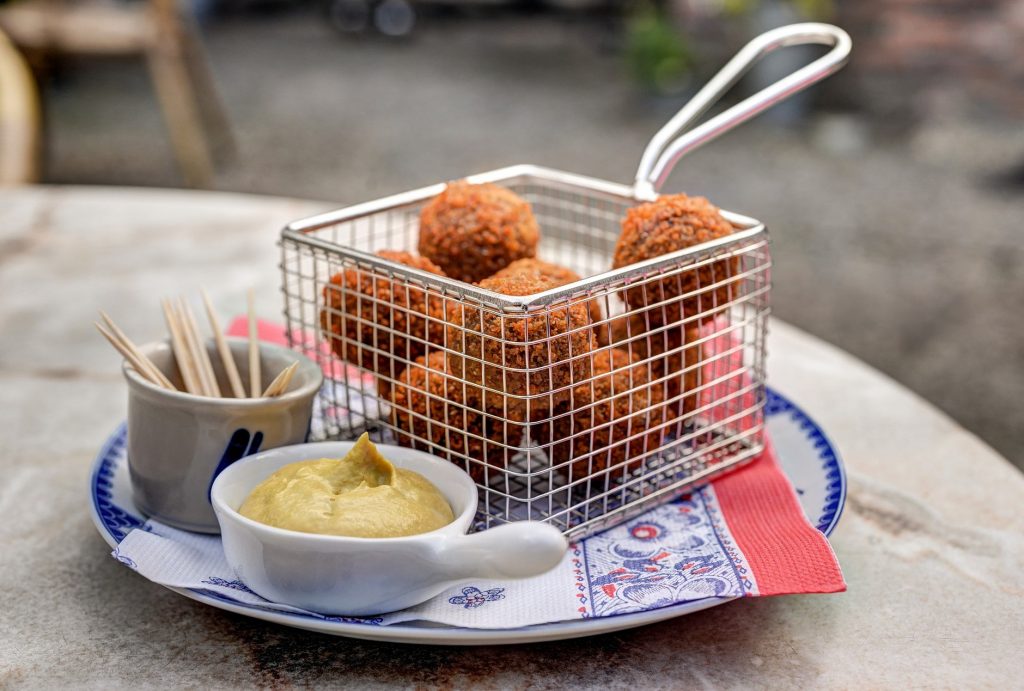
Classic Dutch food – Bitterballen
Bitterballen are a very typical Dutch food – you will find them in every bar and pub. They are deep-fried meat balls filled with a ragout of beef or veal, crispy on the outside and creamy inside. The balls are always served with mustard.
Contrary to the name, Bitterballen are not bitter. The name comes from herb-flavoured liqueurs called bitter – the meat balls are a snack typically eaten with this kind of liqueurs (as well as with beer).
Euroviajar’s Tip
- Be aware that Bitterbalen are very hot inside, so wait a minute and bite cautiously. The Dutch have a lot of fun observing tourists getting burnt while eating them ;)
4.2. Kroketten – Croquettes
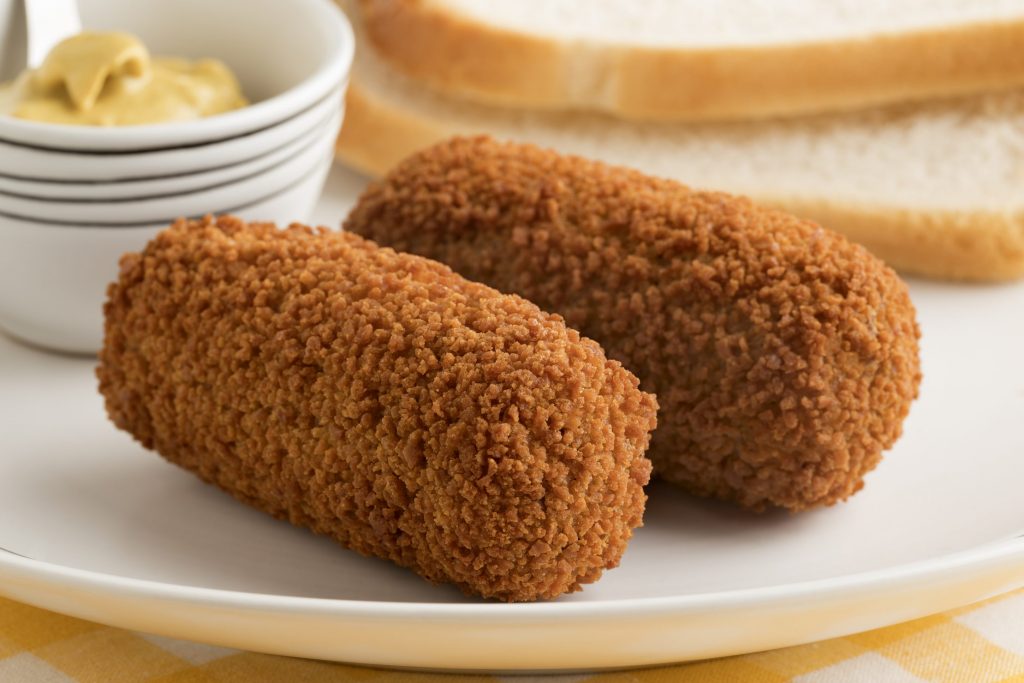
Another typical Dutch food – deep fried croquettes – Kroketten
Kroketten, the classic Dutch food, are actually very similar in taste to Bitterballen, just bigger and in cylindrical shape. They may have different types of fillings: minced meat (pork of beef), potato or potato+meat, shrimps or potato+shrimps, mixed vegatables, peanut sauce. Often served with mustard.
It’s such a popular street food, that there even exist special croquette vending machines branded FEBO! Kroketten are even sold in Dutch McDonald’s.
Euroviajar’s Tips
- If you have to choose, many people say that Bitterballen are better.
- Kroketten are served very hot inside, so be careful not to get your tongue burnt!
4.3. Vlammetjes – Meat “Envelopes”
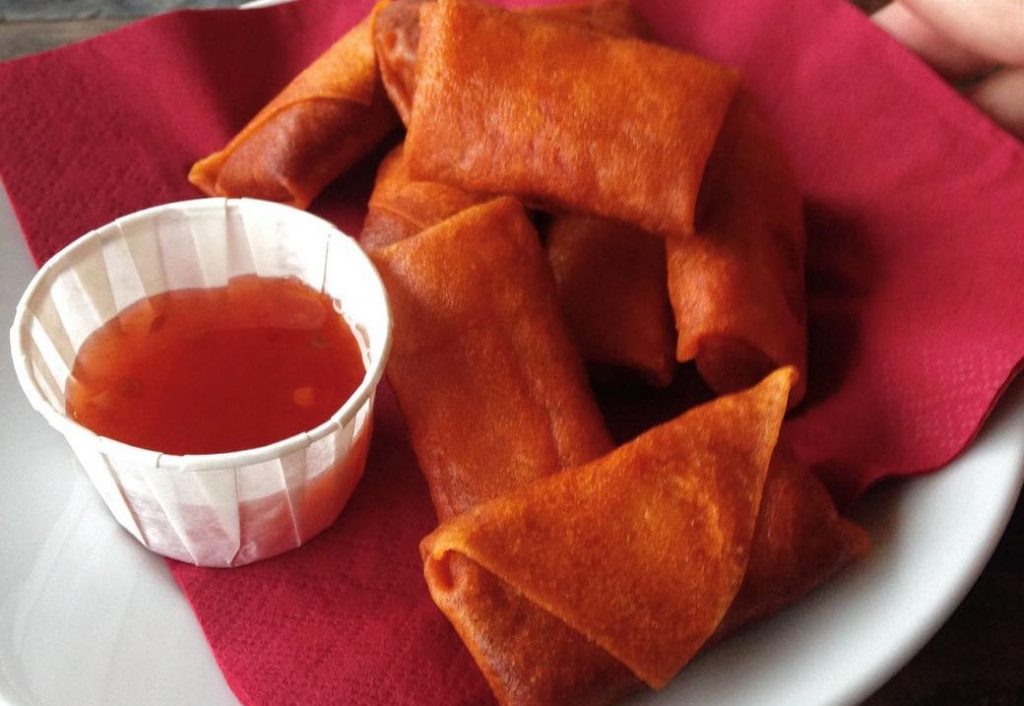
Vlammetjes
The attractive name of this typical Dutch food means “little flames”. Vlammetjes are popular snacks made of deep-fried small envelopes of pastry containing minced beef. They are always served with spicy sweet’n’sour chilli sauce.
4.4. Frikandel – Skinless Sausage
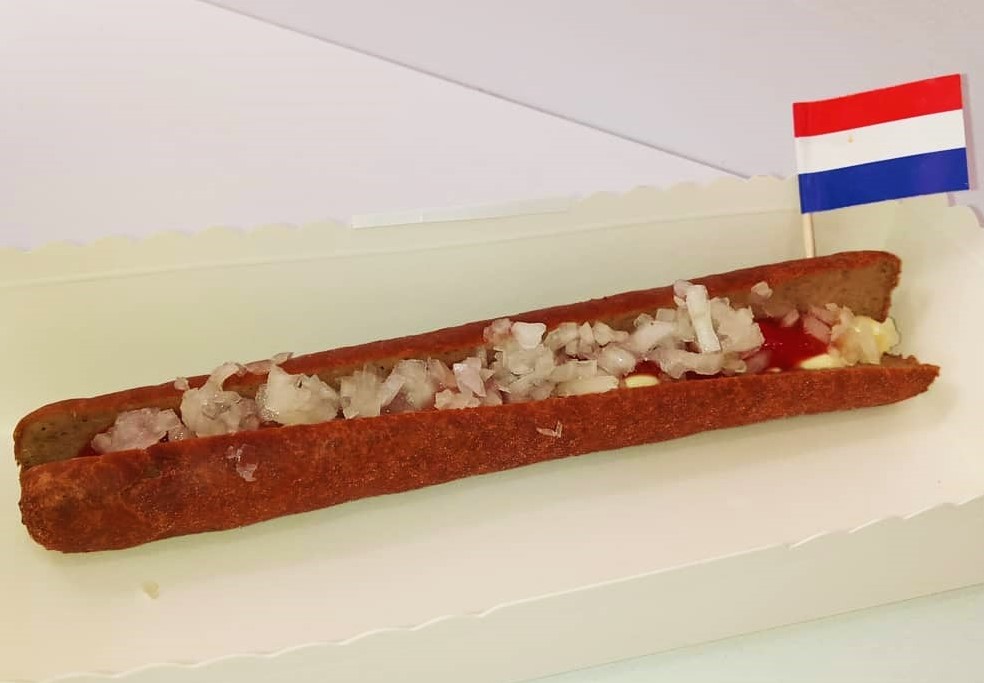
Frikandel
Another classic Dutch food, Frikandel is a deep-fried, skinless long and thin sausage. It can be served with fresh chopped onions and curry ketchup, mayonnaise, or another typical Dutch product – apple sauce, often used with meat or cheeses to add some acidity to the dish.
4.5. Rookworst – Smoked Sausage
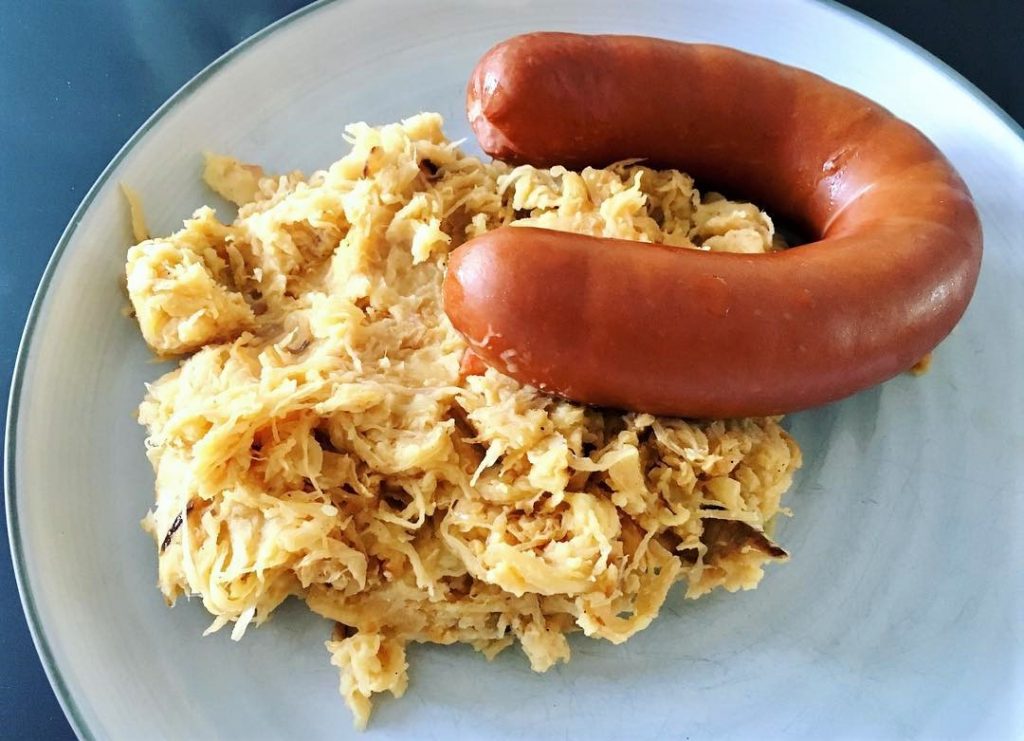
Rookworst sausage
The most popular type of Dutch sausage – Rookworst – is characterized by smoked flavour. It is often served fried with Stamppot (section 1.1. above) or potatoes and sauerkraut, and with pea soup (Erwtensoep – section 4.7. below).
4.6. Ossenworst – Raw Sausage
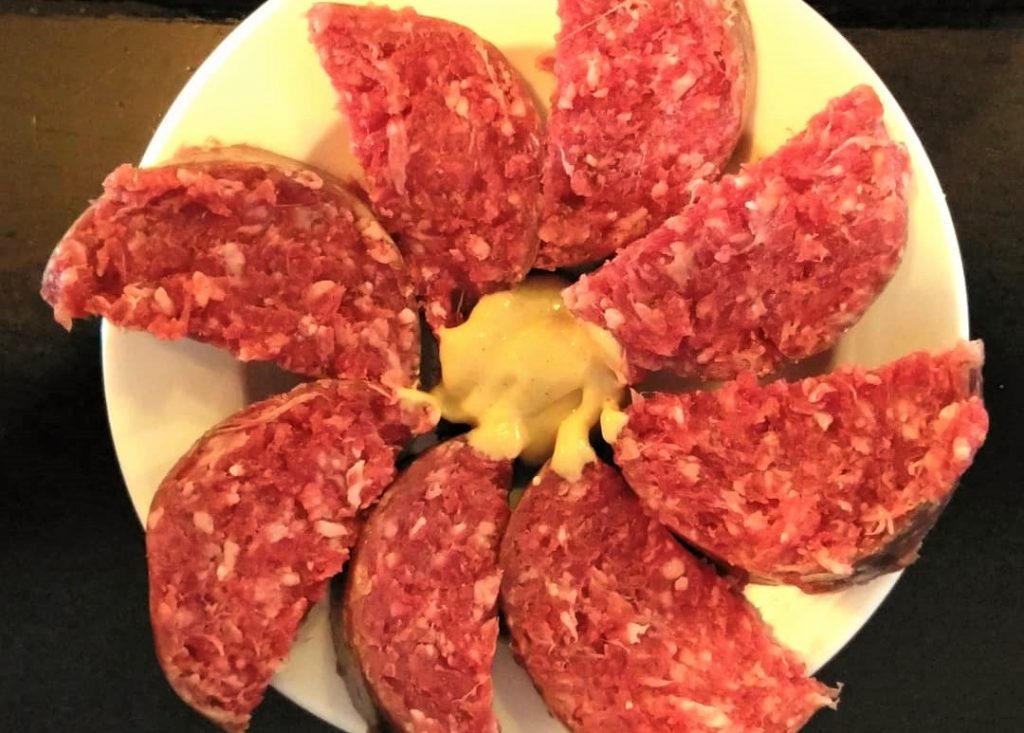
Ossenworst sausage
It is a raw sausage of beef meat, very popular in the Netherlands. It is often served with small pickled onions with saffron and mustard.
4.7. Erwtensoep / Snert – Traditional Dutch Pea Soup

Erwtensoep or Snert – traditional Dutch pea soup
It is a very traditional Dutch thick soup made of peas, leeks, celery, onions and pork sausage – Rookworst (above).
4.8. Indonesian Rijsttafel – “Rice Table”
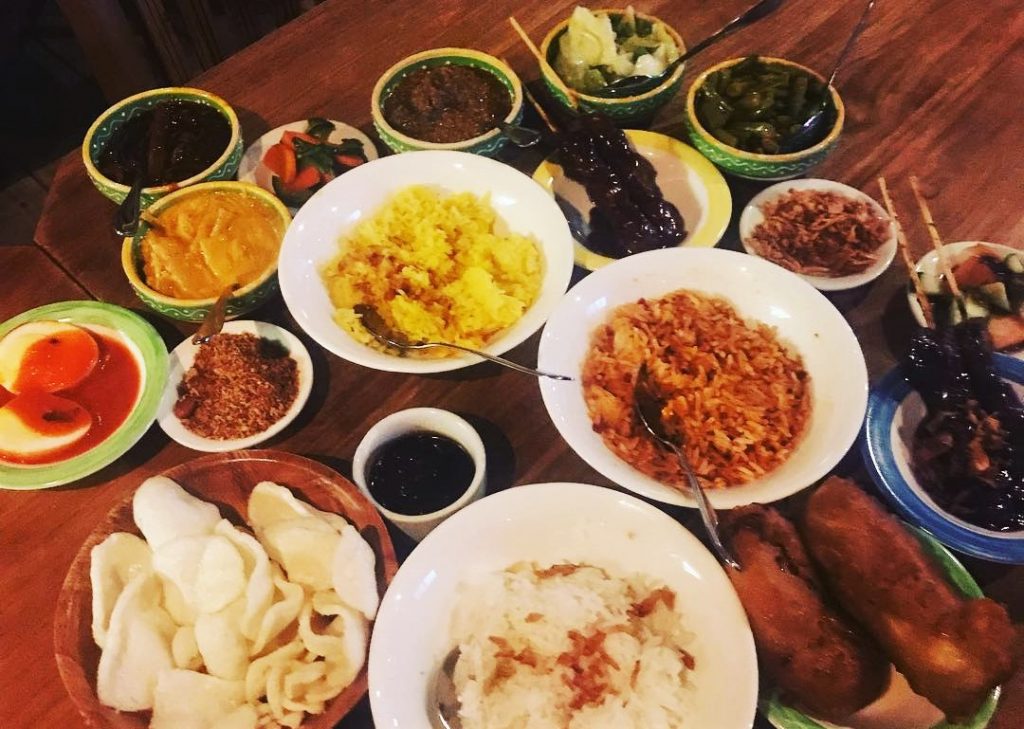
Indonesian Rijstaffel has its place in the gastronomy of the Netherlands
Here is an interesting one. Indonesia was a Dutch colony, called Dutch East Indies, between the 19th and the early 20th century. For this historical connection, the Indonesian cuisine has its traditional place in the Dutch culinary heritage just as the Indian cuisine has its place in the British one.
The Indonesian rijsttafel literally meaning “rice table”, is in fact a colonial dish, assembled to let the Dutch officials staying in Indonesia to taste as many Indonesian specialties as possible in one meal. All the dishes are original and authentic Indonesian dishes, just the idea of putting so many of them together was a Dutch idea.
It consists in a set of many (anything between 10 or even 40) small servings (usually in tiny bowls) of a variety of completely different dishes: rice, meat skewers, various marinated or pickled vegetables, crisps, typical Indonesian peanut sauce (very popular in the Netherlands) etc.
Euroviajar’s Tip
- A trip to the Netherlands wouldn’t be complete without trying the Indonesian cuisine – it’s really part of the Dutch culture
- If instead of full Rijsttafel you prefer to choose just one dish, I recommend Gado-Gado: mixed cooked and fresh vegetables in peanut sauce (vegan dish)
5. Typical Dutch Food: Desserts & Sweets
5.1. Stroopwafel
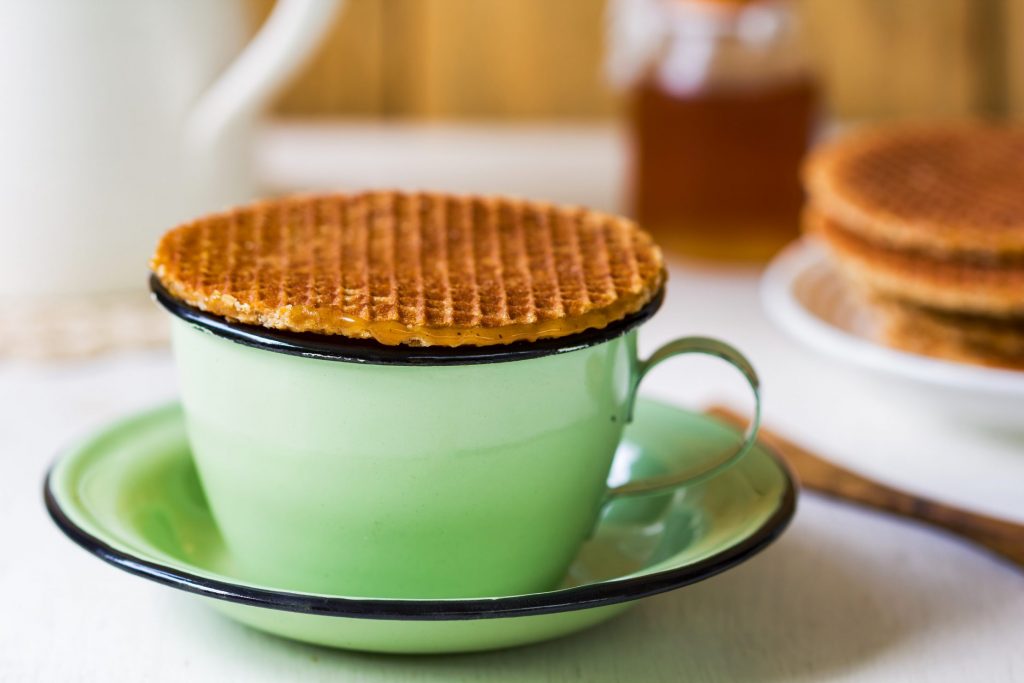
Stroopwafel – the way of serving
The most typical Dutch sweet – world-famous Stroopwafel is a real treat! Its name means “syrup waffle” and it consists of two layers of round crunchy waffle with oozing caramel filling in between them. You should eat it as shown on the photo: placing it over a coffee or tea cup, waiting a moment until the syrup melts.
The nation’s most beloved cookie was invented in the city of Gouda – even more famous for its cheese, and that’s where they Stroopwafels better than anywhere else. They make them thinner and bake them twice, and that makes a really huge difference in taste.
5.2. Poffertjes – Mini Pancakes
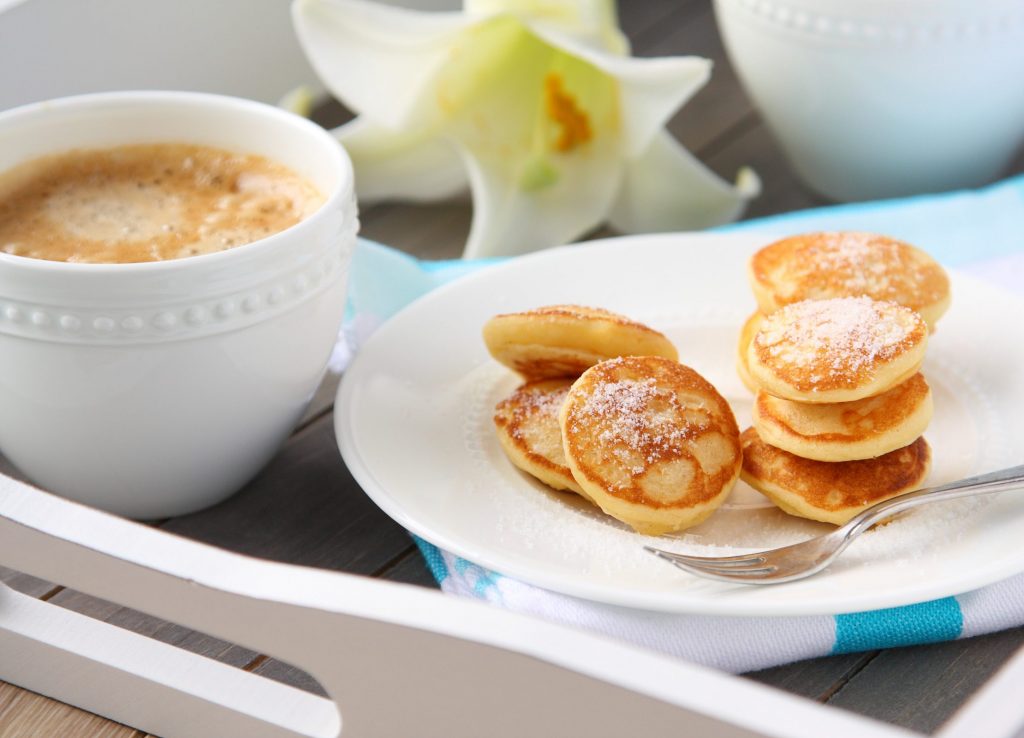
Poffertjes – super cute and delicious Dutch mini sweet pancakes
Sweet pancakes are an international dessert coming in different varieties, but nobody else makes them like the Dutch. The Dutch Poffertjes are very tiny, which makes them a very cute dessert, and they are delicious. Poffertjes are usually served just with a dice of butter and powdered sugar, but you can take them also with chocolate sauce or cherry marmalade etc. They are both a popular street food and a dessert served in most cafés.
22 Beautiful Photos That Will Make You Fall In Love With The Netherlands
5.3. Appeltaart – Apple Pie
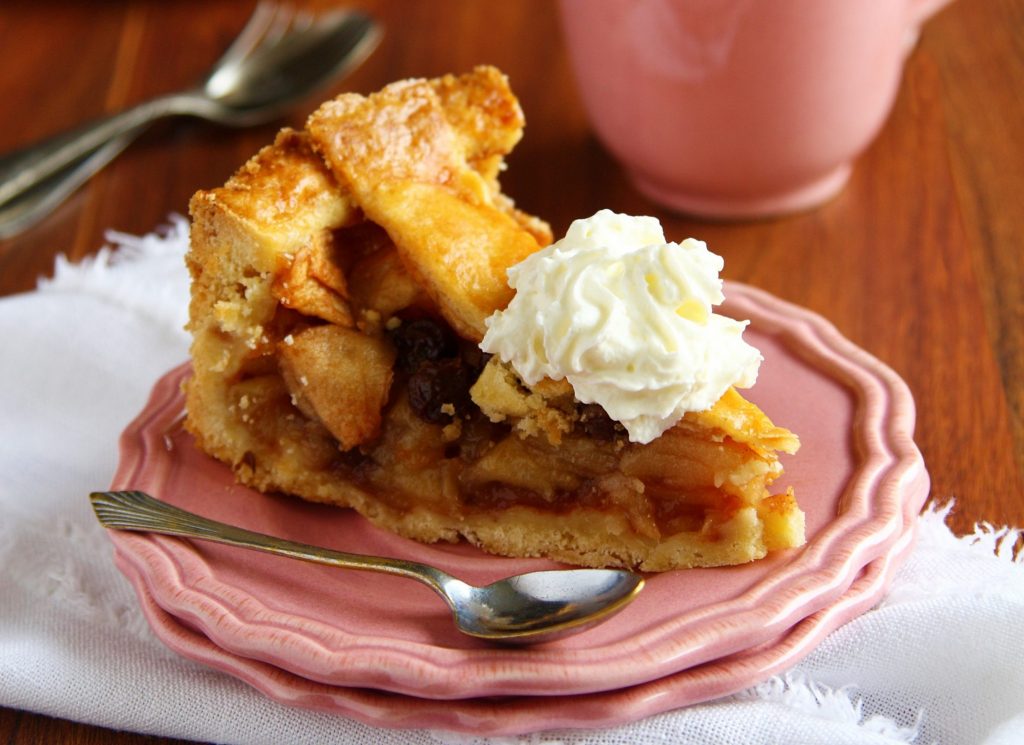
Dutch apple pie – Appeltaart
Coming from Poland, a country specialized in spectacular cakes of infinite types, I’m not easy to impress by a pie. But Dutch-style apple tart is pure perfection. It always looks more-less like on this photo – it is high and filled in 90% with sliced apples, with just an external crust of pastry around it. It’s neither too sweet or too fat – it’s ideal, every time, everywhere. And the portions are always generous. One of the world’s best apple pie for sure!
https://euroviajar.com/en/guide-to-vienna/
5.4. Tompouce – Cream Cake

Typical Dutch pastry – Tompouce
Tompouce is a delicious rectangular puff pastry filled with thick cream with characteristic pink icing.
For the King’s Day, the icing is changed to orange to celebrate the Dutch Orange dynasty :)
5.5. Gevulde Koeken – Marzipan Cookies

Gevulde Koeken – Typical Dutch marzipan-filled cookies
Behind a rather unimaginative name meaning “filled cookie” hides a real fantastic taste! It’s a butter cookie with thick layer of marzipan, and trust me – it’s exquisite! You will easily find it in bakeries, markets and supermarkets.
5.6. Speculaas – Crunchy Gingerbread
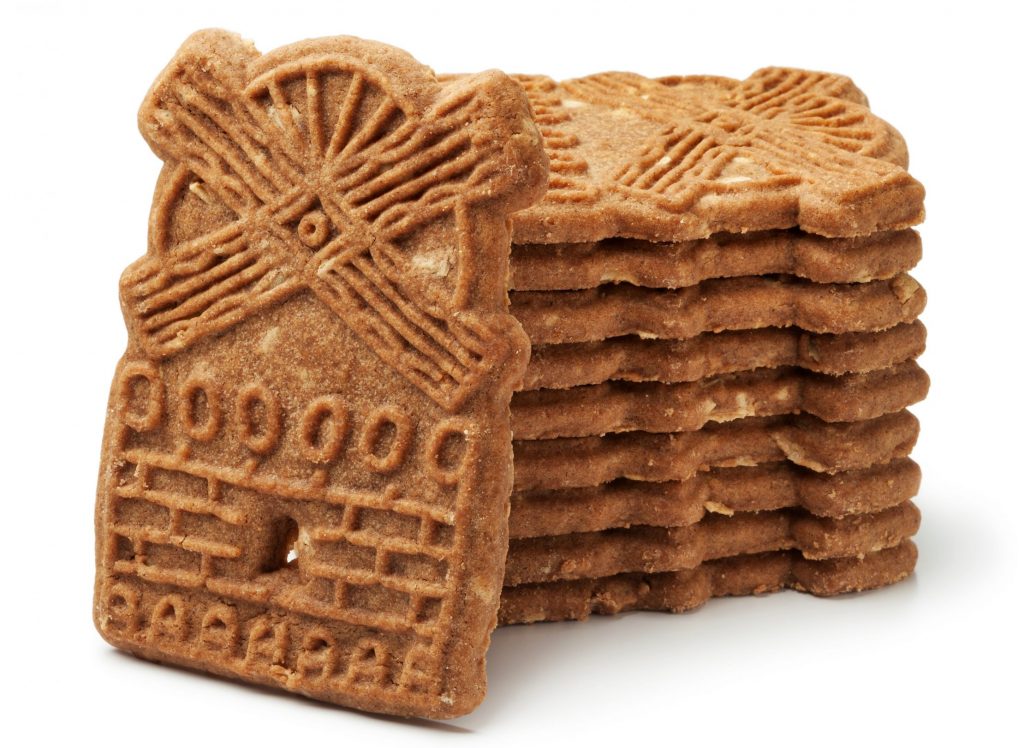
Traditional Dutch Speculaas cookies
Speculaas is a crunchy gingerbread butter cookie. It is eaten mostly around Christmas time and for Sinterklaas (Santa Claus) festivities in the Netherlands. The Dutch love the Speculaas taste so much, that during winter you can also find speculaas coffee, speculaas ice-cream, speculaas filled with marzipan, speculaas bread spread etc.
5.7. Kruidnoten / Pepernoten – Hard Gingerbread Cookies
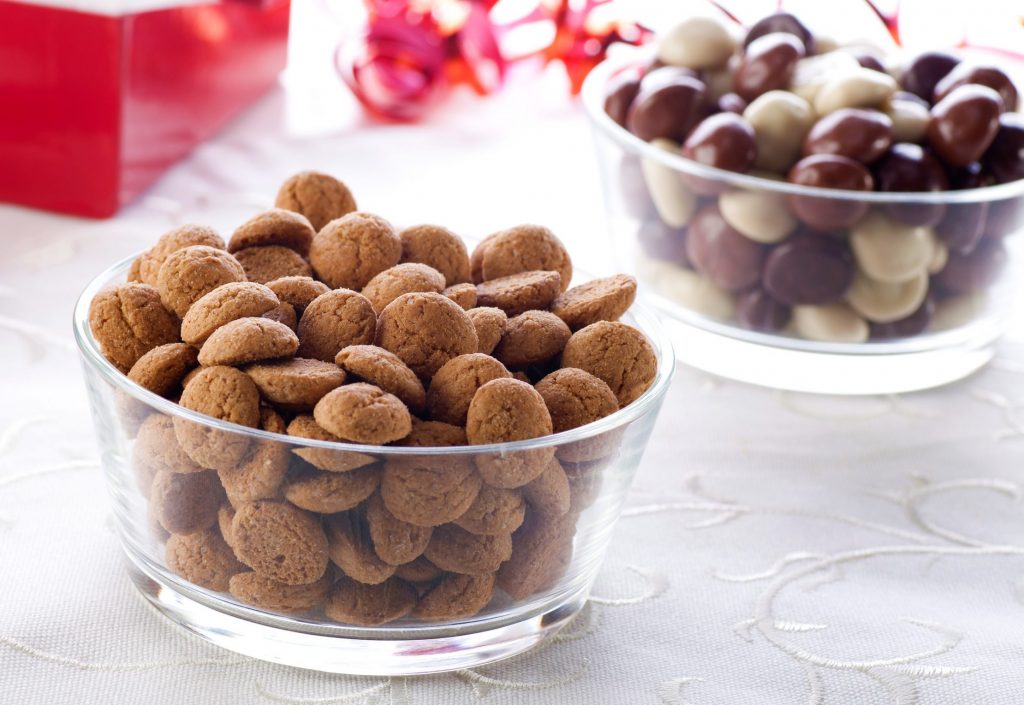
Kruidnoten or Pepernoten
The name Kruidnoten means “spice nuts”. They are tiny round crispy gingerbread cookies. There is a version covered in chocolate, too (on the photo you can see both types). Kruidnoten have roughly the same taste as Speculaas.
Pepernoten – “pepper nuts” – are a bit brighter in colour and less hard, spiced with cinnamon, cloves, anise etc. Both types of cookies are given to children in December for Sinterklaas.
5.8. Oliebollen – Dutch Doughnuts
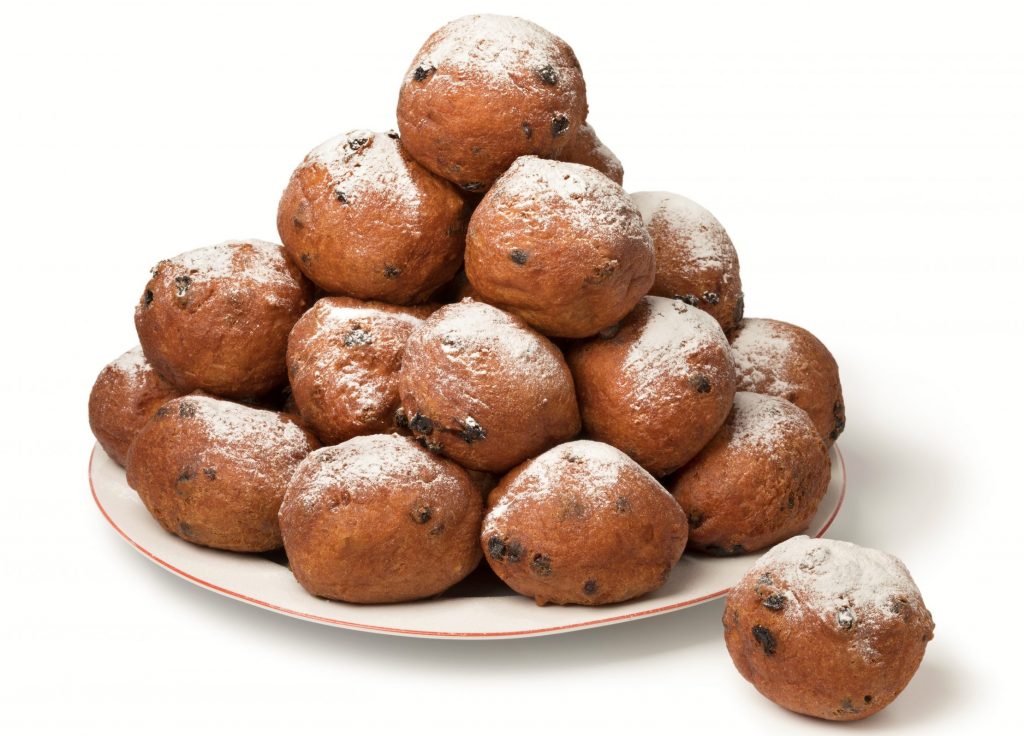
Oliebollen – Dutch doughnuts
Oliebollen are simple doughnuts with raisins, traditionally without any filling. The Dutch eat them at the New Year’s Eve, and there are always stalls with them on Christmas markets everywhere in the Netherlands.
5.9. Drop – Liquorice Candies
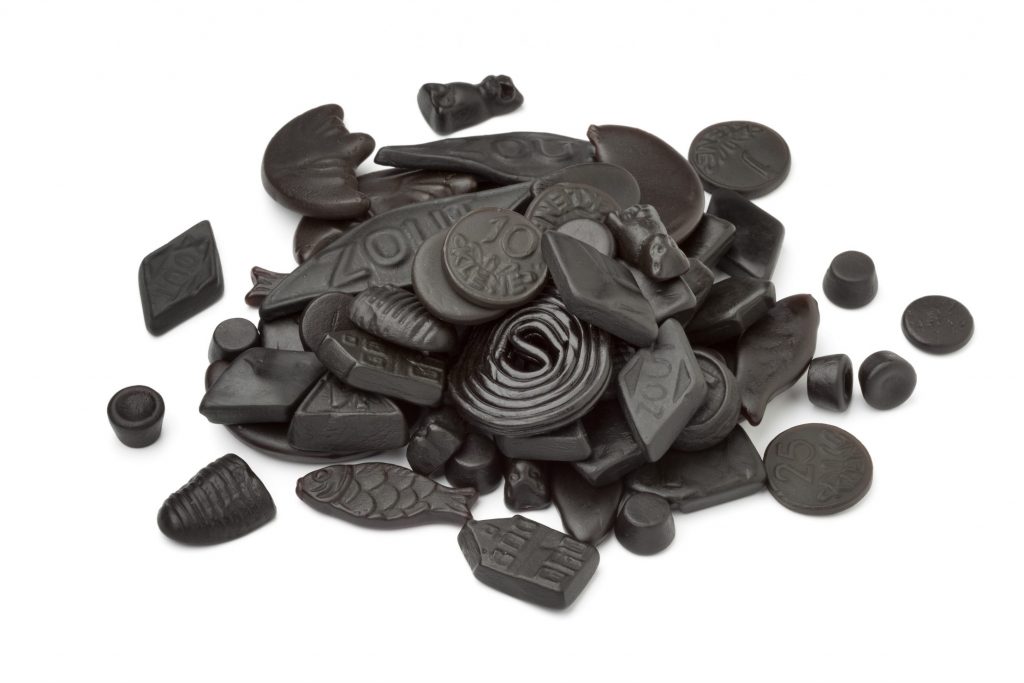
Liquorice candies
Drop is the Dutch word for liquorice candy, which I can loosely translate for you as “You’ll drop dead if you taste it!” Really, it’s horrible. But for some inexplicable reason, the Dutch – as all the Scandinavian nations – absolutely love it. (But almost nobody else does, except for my Brother, who loves it too.)
You can find liquorice candy everywhere, in every form and shape. It can be sweet or salty, hard or soft. The most terrible version is the salty one – Salmiak.
The Dutch have a lot of fun innocently giving a Salmiak candy to unsuspecting foreigners to watch the grimace at their faces when they try this arguably one of the most disgusting candies on Earth ;)
Do you agree that it’s terrible or you actually like it? Vote in the comment and say where you come from ;)
5.10. Hagelslag – Chocolate Sprinkles
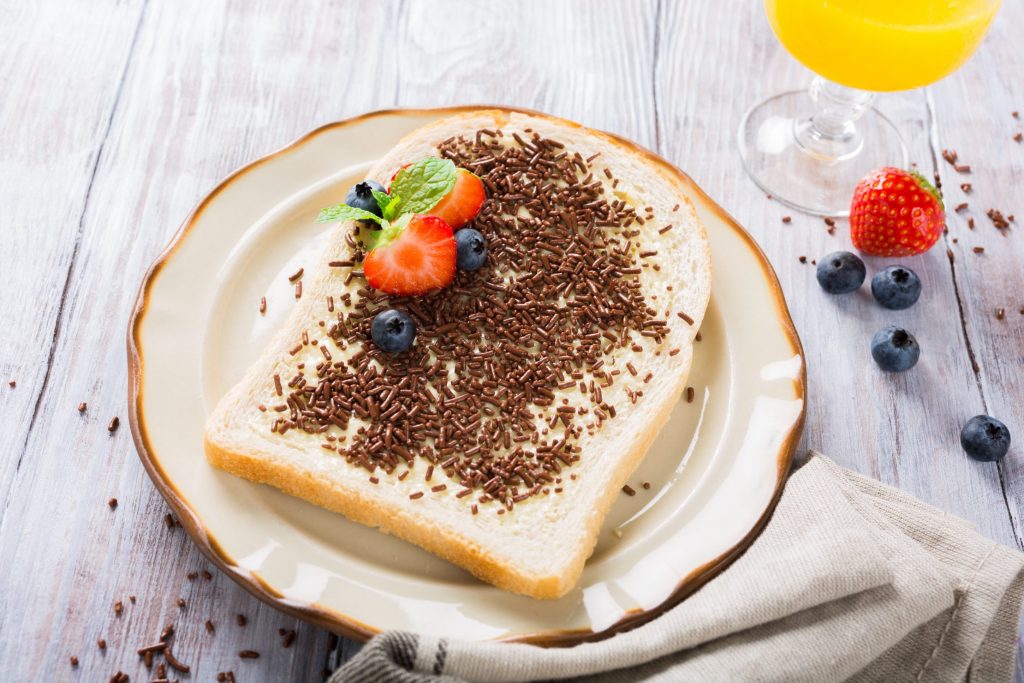
Hagelslag chocolate sprinkles on bread
Hagelslag are chocolate (or colourful sugar) sprinkles – other nations use them as an icing for cakes, the Dutch use them with bread and butter for breakfast… And it’s really a regular everyday breakfast. You would be surprised how popular they are throughout the Netherlands!
6. Typical Dutch Drinks
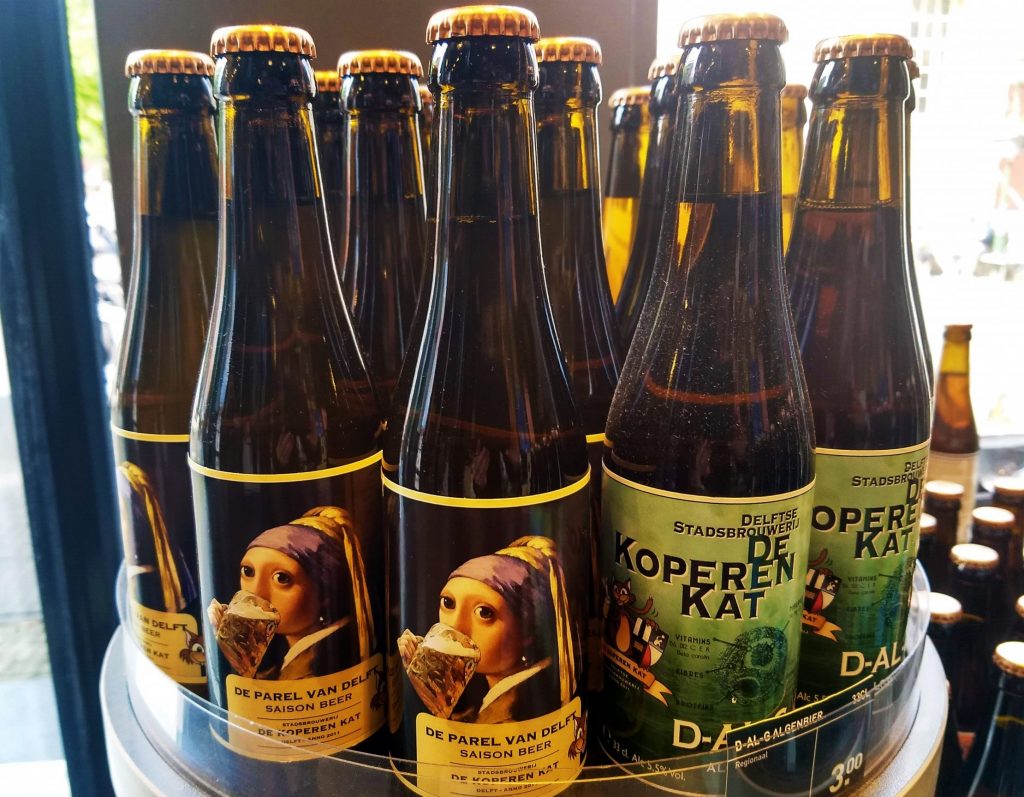
Best Dutch beers are craft beers from small local breweries
Read the detailed Guide to Typical Dutch Drinks – Beer & Spirits
6.1. Dutch Beers
The Dutch love beer. In every pub you’ll find dozens of beers, divided into categories that (apart from the last two) are rarely known outside Belgium, the Netherlands and Germany, such as the following:
- Bokbier
- Saison
- Witbier
- Dubbel
- Tripel
- Quadrupel
- Pale Lager
- IPA
To help you out and make you enjoy fully what you order, we prepared the Guide to Typical Dutch Drinks – Beer & Spirits.
6.2. Dutch Spirits
- Jenever
- Advocaat
- Dropshot
- Oranjebitter
Read the detailed Guide to Typical Dutch Drinks – Beer & Spirits
Read about Nightlife in Amsterdam
Read about Best Restaurants in Amsterdam & Areas to Eat Out
Other Typical Dutch Foods
Any other typical Dutch dishes or snack you’d like to add? Any comments of what you’ve tried / hated / loved etc.? Any thoughts on the liquorice candy ;) Share them in a comment!
8 thoughts on “Typical Dutch Food – 25 Traditional Dishes & Desserts”
Leave a Reply
More articles about Food
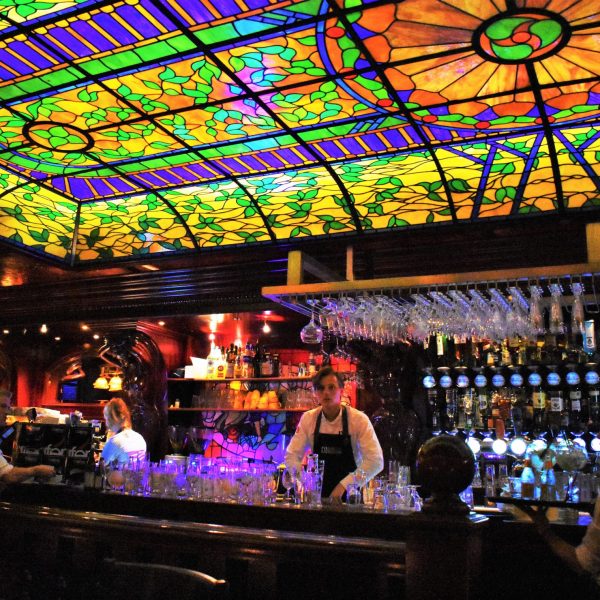
Typical Dutch Drinks – Beer & Spirits
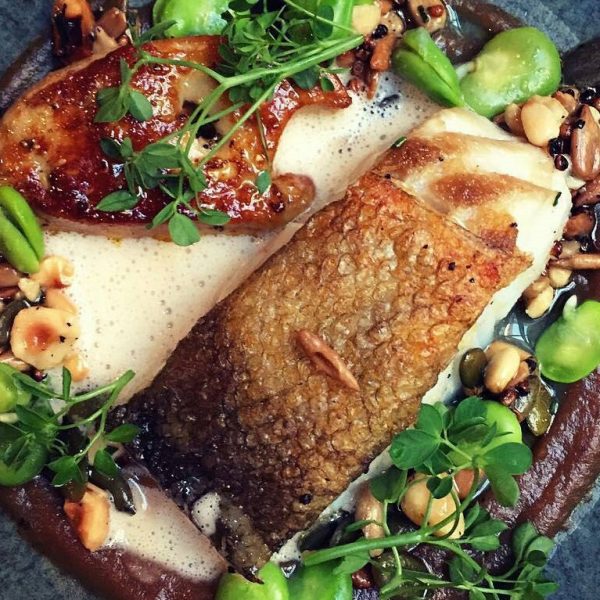
Best Restaurants in Amsterdam & Areas to Eat Out
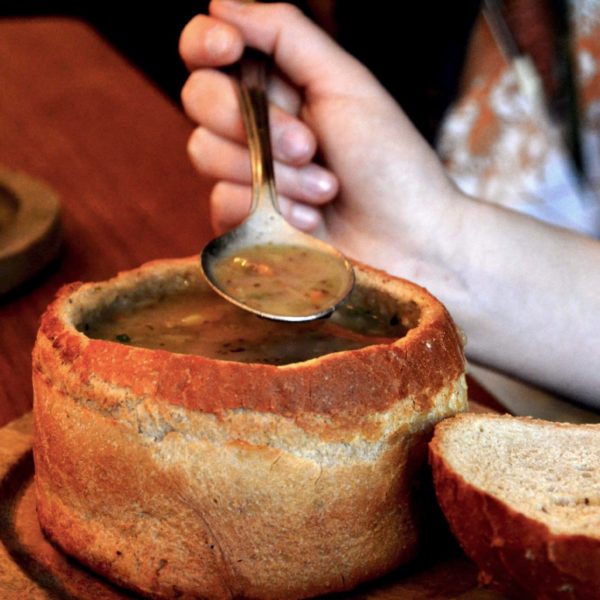
Typical Czech Food – 25 Traditional Dishes & Desserts
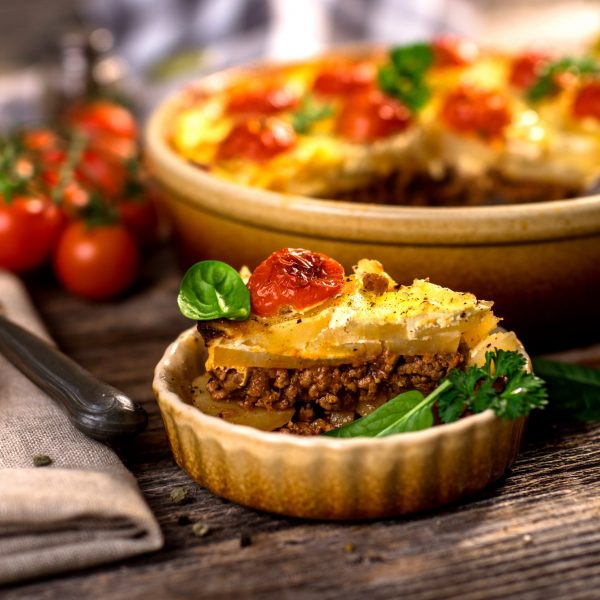
Typical Greek Food – 30 Traditional Dishes & Desserts

Typical Austrian Food – 20 Traditional Dishes & Desserts




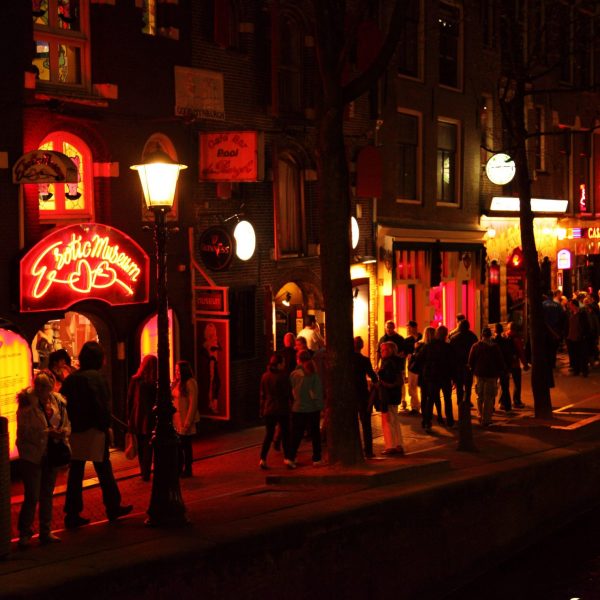

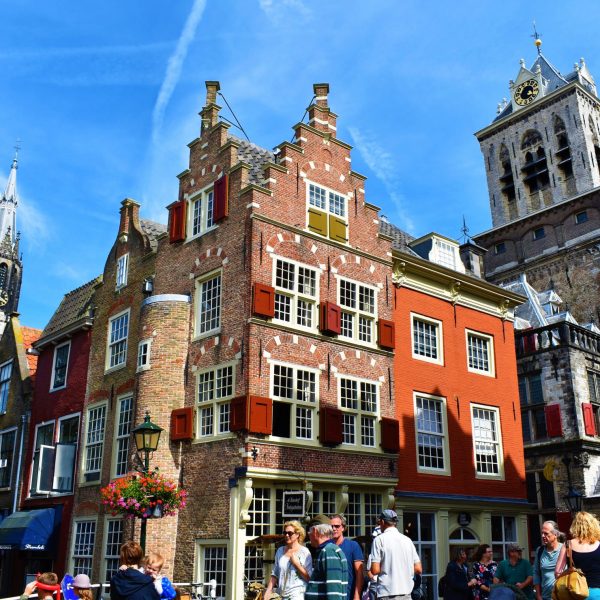
Mustard soup is the best Dutch food! I LOVE it! :D
Thanks for very good explanation of Dutch cheeses. If I only want to buy two types of Dutch cheese, which ones do you recommend?
Hi Elisa, I highly recommend Nagelkaas – cheese with cloves, it is a taste you won’t find anywhere else. All my family loved it. I also recommend delicious “Old Amsterdam” – it is a mature gouda cheese of extremely rich taste. If you can’t find it, ask for another extra-mature gouda.
Yeah vegan food which is traditional or typical is really hard to find, specially in north countries. Good tip with Indonesian cuisine, that’s something new to try. Do you know some good restaurants in Amsterdam where I can try it?
Hi Katerina, you will find some great vegan options in our article: https://euroviajar.com/en/best-restaurants-in-amsterdam-areas-to-eat-out/ We list not only a great Indonesian restaurant, but also 5 best vegan restaurants in Amsterdam, which serve also vegan Dutch food. Bon appetit :)
The Stamppot, Kaaskroketten, Mosterdsoep & other Dutch dishes that you shared in your blog look delicious. I never got the opportunity to visit the Netherlands but your blog has nudged me to apply for a Visa for Netherlands. Since our anniversary is coming up next month, I’ll keep this getaway as a surprise gift for my lovely wife. I hope she likes it.
Oh Why did I come across this page? Now feel absolutely starving. Brought up in the UK with a Dutch mother – taught (at a very young age) to love chocolate sprinkles on white bread and butter (MUST be white) chips and mayonaise and all the rest. One important thing you have left out! Where’s the chocomel? Surely a must? Everyone drinks this instead of pop.
Typical Dutch food is so weird! Full of surprises :) It was interesting to discover more